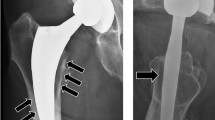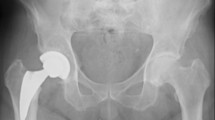Abstract
Introduction
Uncemented short, curved femoral stems may help save proximal bone stock during total hip arthroplasty (THA) and facilitate insertion in minimal invasive surgery. The aim of this 2 year, prospective, single-center study was to examine the stability and migration of the Fitmore® stem in THA using model-based radiostereometric analysis (RSA), and thus predict the implant’s long-term survival. In addition, we evaluated the stem’s clinical performance using standard clinical measures.
Patients and methods
We conducted a prospective cohort study of 34 THA patients who received the short Fitmore Hip Stem (Zimmer, Winterthur, Switzerland). At 3, 6, 12 and 24 months postoperatively, the patients underwent clinical evaluation and radiostereometric analysis (RSA) to measure stem migration.
Results
RSA analysis revealed a mean subsidence of −0.39 mm (95 % CI −0.60 to −0.18) at 3 months with no further migration after 2 years. Mean internal rotation along the longitudinal axis was 1.09° (95 % CI 0.52–1.66) at 2 years, versus 0.85° (95 % CI 0.44–1.26) at 3 months. The Harris hip score improved from 60 (range 30–80) preoperatively to 99 (range 83–100) after 2 years. Three patients underwent revision due to deep infection, non-specific thigh pain and aseptic loosening in one case.
Conclusion
We conclude that the Fitmore Hip Stem stabilizes after 3 months and achieves good short-term clinical results in most cases.





Similar content being viewed by others
References
Aro HT, Alm JJ, Moritz N et al (2012) Low BMD affects initial stability and delays stem osseointegration in cementless total hip arthroplasty in women: a 2-year RSA study of 39 patients. Acta Orthop 83:107–114
Bauer R, Kerschbaumer F, Poisel S et al (1979) The transgluteal approach to the hip joint. Arch Orthop Trauma Surg 95:47–49
Bieger R, Ignatius A, Decking R et al (2012) Primary stability and strain distribution of cementless hip stems as a function of implant design. Clin Biomech (Bristol, Avon) 27:158–164
Boe BG, Rohrl SM, Heier T et al (2011) A prospective randomized study comparing electrochemically deposited hydroxyapatite and plasma-sprayed hydroxyapatite on titanium stems. Acta Orthop 82:13–19
Dawson J, Fitzpatrick R, Murray D et al (1998) Questionnaire on the perceptions of patients about total knee replacement. J Bone Joit Surg BR 80:63–69
De Vries LM, Van Der Weegen W, Pilot P et al (2014) The predictive value of radiostereometric analysis for stem survival in total hip arthroplasty. A systematic review. Hip Int 24:215–222
Engh CA, O’connor D, Jasty M et al (1992) Quantification of implant micromotion, strain shielding, and bone resorption with porous-coated anatomic medullary locking femoral prostheses. Clin Orthop Relat Res 285:13–29
Floerkemeier T, Budde S, Gronewold J et al (2015) Short-stem hip arthroplasty in osteonecrosis of the femoral head. Arch Orthop Trauma Surg 135:715–722
Freitag T, Hein MA, Wernerus D et al. (2015) Bone remodelling after femoral short stem implantation in total hip arthroplasty: 1-year results from a randomized DEXA study. Arch orthop trauma surg [Epub ahead of print]
Freitag T, Kappe T, Fuchs M et al (2014) Migration pattern of a femoral short-stem prosthesis: a 2-year EBRA-FCA-study. Arch Orthop Trauma Surg 134:1003–1008
Gotze C, Steens W, Vieth V et al (2002) Primary stability in cementless femoral stems: custom-made versus conventional femoral prosthesis. Clin Biomech (Bristol, Avon) 17:267–273
Gruen TA, Mcneice GM, Amstutz HC (1979) “Modes of failure” of cemented stem-type femoral components: a radiographic analysis of loosening. Clin Orthop Relat Res 141:17–27
Gustke K (2012) Short stems for total hip arthroplasty: initial experience with the Fitmore stem. J Bone Joint Surg (Br) 94:47–51
Harris WH (1969) Traumatic arthritis of the hip after dislocation and acetabular fractures: treatment by mold arthroplasty. An end-result study using a new method of result evaluation. J Bone Joint Surg (Am) 51:737–755
Hurschler C, Seehaus F, Emmerich J et al (2008) Accuracy of model-based RSA contour reduction in a typical clinical application. Clin Orthop Relat Res 466:1978–1986
Jahnke A, Engl S, Seeger JB et al (2015) Influences of fit and fill following hip arthroplasty using a cementless short-stem prosthesis. Arch Orthop Trauma Surg 135:1609–1614
Jasty M, Bragdon C, Burke D et al (1997) In vivo skeletal responses to porous-surfaced implants subjected to small induced motions. J Bone Joint Surg Am 79:707–714
Karrholm J, Borssen B, Lowenhielm G et al (1994) Does early micromotion of femoral stem prostheses matter? 4–7 year stereoradiographic follow-up of 84 cemented prostheses. J Bone Joint Surg Br 76:912–917
Krismer M, Biedermann R, Stockl B et al (1999) The prediction of failure of the stem in THR by measurement of early migration using EBRA-FCA. Einzel-Bild-Roentgen-Analyse-femoral component analysis. J Bone Joint Surg Br 81:273–280
Loudon JR, Charnley J (1980) Subsidence of the femoral prosthesis in total hip replacement in relation to the design of the stem. J Bone Joint Surg Br 62-B:450–453
Mjoberg B (1994) Theories of wear and loosening in hip prostheses. Wear-induced loosening vs loosening-induced wear–a review. Acta Orthop Scand 65:361–371
Nunn D, Freeman MA, Tanner KE et al (1989) Torsional stability of the femoral component of hip arthroplasty. Response to an anteriorly applied load. J Bone Joint Surg Br 71:452–455
Patel RM, Smith MC, Woodward CC et al (2012) Stable fixation of short-stem femoral implants in patients 70 years and older. Clin Orthop Relat Res 470:442–449
Pepke W, Nadorf J, Ewerbeck V et al (2014) Primary stability of the Fitmore stem: biomechanical comparison. Int Orthop 38:483–488
Pijls BG, Nieuwenhuijse MJ, Fiocco M et al (2012) Early proximal migration of cups is associated with late revision in THA: a systematic review and meta-analysis of 26 RSA studies and 49 survival studies. Acta Orthop 83:583–591
Ranstam J, Ryd L, Onsten I (2000) Accurate accuracy assessment: review of basic principles. Acta Orthop Scand 71:106–108
Rohrl SM, Li MG, Pedersen E et al (2006) Migration pattern of a short femoral neck preserving stem. Clin Orthop Relat Res 448:73–78
Rottinger H (2010) Minimally invasive anterolateral approach for total hip replacement (OCM technique). Oper Orthop Traumatol 22:421–430
Ryd L, Albrektsson BE, Carlsson L et al (1995) Roentgen stereophotogrammetric analysis as a predictor of mechanical loosening of knee prostheses. J Bone Joint Surg Br 77:377–383
Soballe K, Hansen ES, H BR et al (1992) Tissue ingrowth into titanium and hydroxyapatite-coated implants during stable and unstable mechanical conditions. J Orthop Res 10:285–299
Swanson TV (2005) The tapered press fit total hip arthroplasty: a European alternative. J Arthroplasty 20:63–67
Valstar ER, Gill R, Ryd L et al (2005) Guidelines for standardization of radiostereometry (RSA) of implants. Acta Orthop 76:563–572
Van Oldenrijk J, Molleman J, Klaver M et al (2014) Revision rate after short-stem total hip arthroplasty: a systematic review of 49 studies. Acta Orthop 85:250–258
Wolf O, Mattsson P, Milbrink J et al (2010) Periprosthetic bone mineral density and fixation of the uncemented CLS stem related to different weight bearing regimes: a randomized study using DXA and RSA in 38 patients followed for 5 years. Acta Orthop 81:286–291
Acknowledgments
We thank Bart Kaptein and Lennard Koster for the RSA analysis and for technical support, and Tina Stölzle for general study support.
Author information
Authors and Affiliations
Corresponding author
Ethics declarations
Conflicts of interest
The authors declare that they have no conflict of interest.
Funding sources
This study received financial support for statistic and RSA analysis from Zimmer GmbH.
Rights and permissions
About this article
Cite this article
Acklin, Y.P., Jenni, R., Bereiter, H. et al. Prospective clinical and radiostereometric analysis of the Fitmore short-stem total hip arthroplasty. Arch Orthop Trauma Surg 136, 277–284 (2016). https://doi.org/10.1007/s00402-015-2401-9
Received:
Published:
Issue Date:
DOI: https://doi.org/10.1007/s00402-015-2401-9




